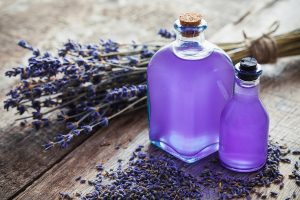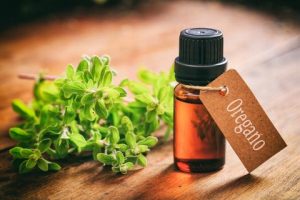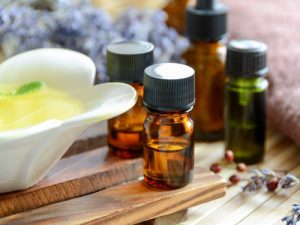Essential oils have re-emerged as a popular branch of Holistic Healthcare in North America.
They are effective for numerous uses in daily Life and can replace many sources of toxicity that are still being used in most conventional households. But what exactly are essential oils?
E.O.s are concentrated, aromatic oils drawn directly from the bark, resins, flower, fruit, leaf, seed or root of a plant or tree. These are the natural compounds, within the plant, that defend against ravenous insects, attract pollinators, and shield the plant from harsh weather and environmental conditions.
Typically extracted through the process of steam distillation, the volatile, oily constituents are separated from the water-based compounds of the plant. Essential oils are highly concentrated and often have a strong aroma. Did you know that it takes 29.5 kg of rose petals to make only 15ml of essential oil?! The powerful healing properties are maximized, in this manner, and can penetrate your skin cells and cross the blood-brain barrier (absorbing directly into the blood stream without having to be assimilated in the digestive system).

Essential oils have been the basis for botanical medicines for millennia in all the world’s major cultures. In China they were listed in Shennong’s Herbal, the oldest living medical text book in the world (written around 2700 B.C.). They were (and still are) widely used in India, first developing in the Ayurvedic tradition (practiced for at least 5000 years) which considers, and treats, the mind, body, and the Spirit. The most popular oils would have been those that offered the highest therapeutic value and grew in the native region close to civilizations.
By 2000 B.C. the Egyptian elite were using aromatic extracts for beauty care, basic healthcare and for culinary uses. Temple priests (who also acted as the physicians of the day) used them in Spiritual rituals, to embalm their deceased and as potent medicines. The ancient Greek physician, Hippocrates, used fumigation in the city of Athens to combat the plague and prescribed aromatic treatments for fallen soldiers on the battlefields. The knowledge of these powerful extracts was passed from the Greeks to the Romans, who used many oils hedonistically for bathing and massage. Eventually, this tradition spread to Europe with the invading Roman armies.
During the Middle Ages aromatic herbs and oils were deemed decadent and inappropriate by the Catholic Church. Medicinal uses declined greatly, but some were still used for their pleasant aromas and in religious ceremonies as incenses. Eventually the use of such herbs and plants by laymen, in the healing arts, was labelled witchcraft and many that held onto these practices were persecuted and burned at the stake. Ironically, both the Old and New Testament reference at least 12 aromatic plants and essential oils more than nine times, including cedarwood, frankincense, fir, cinnamon, and myrrh.
By the 1800’s the popularity of essentials oils, in healthcare, remerged in England, Germany and France, with the latter becoming the source of the world’s most sought-after perfumes. The first ever recorded lab test, of the anti-bacterial potential of essential oils was done in 1887. By the 1920’s a French cosmetic chemist named Rene-Maurice Gattefosse, coined the term “aromatherapie” as the treatment of disease and injury after successfully treating his own severe gas burns with just one rinse of lavender essential oil. Currently in England, Germany, and France it is common for physicians to allow their patients to choose between prescription medication or naturally distilled essential oils for their treatment. North American hospitals are slowly catching on to the major benefits of essential oils for anxiety, depression, and infections.
There are many ways to use essential oils in your daily lifestyle. They are often used topically, diluted with a carrier oil like Sweet Almond, Coconut, and Jojoba, to help nourish the skin and slow the transfer of the aromatic compounds, delivering their powerful healing properties to the organ systems of the body. When diffused the active compounds are absorbed through lung tissue and enter the blood stream helping to calm the mind and nervous system and to protect immunity, killing many pathogenic invaders lurking in the air. Blending essential oils into homemade body butters, toothpastes, bug sprays, lip balms, bath salts, and household cleaners is a great way to benefit from their protective, calming, germ-killing and uplifting qualities.
Make sure to check with your Holistic or Functional-Medicine Practitioner before using them internally as they are extremely powerful and may interact with some pharmaceutical medications or cause an allergic reaction. If you’re pregnant or breast-feeding consult with your Healthcare Provider first. Less is always more when using essential oils! Be sure to do your homework too, before buying essential oils. Look for Organic, 100% pure distilled extractions, with no solvents. Knowing that the counties of origin, for the raw plants and herbs, are not violating human rights, or harming the natural environment, is important too!
The following are just a handful of the most popular and therapeutic oils that can be used in your daily lifestyle:
Lavender

Is currently the most popular and frequently used essential oil in the world. Use it for bathing, cooking, and purifying the air as it has strong antimicrobial, sedative, calming and anti-depressive qualities. Diffuse it in the bedroom or apply it topically to the temples and back of neck to ease headaches and help improve your quality of sleep. Lavender Hybrid Super is great for burns, cuts, scrapes and wounds; it is one of the few oils that is gentle enough to apply undiluted directly to wounds.
Oil of Oregano

Has powerful anti-microbial properties and is now a well-known remedy for the common cold. Use higher doses, for a few days after the first symptoms appear. Gargle with it in warm water and then swallow. It is hot and spicy in the mouth, so use it in capsule form if sensitive. Rub O.O.O. behind the ears for ear infections (never inside the ear!!).
Thieves’ Oil Blend

A wonderful oil to diffuse around the house during the holidays and for cold and flu season. It is a blend of many oils including cinnamon, clove, eucalyptus, lemon, rosemary, and thyme. Many brands have their own version of this antibacterial and antiviral blend. Thieves’ is also great for travel and can help to prevent airborne viruses, in close quarters, and can be used as a quick bug-spray (dilute with water and spray as needed).
Tea Tree
Is well-known in the Holistic Health sector as a powerful anti-bacterial, anti-fungal agent that helps to stimulate the immune system and reduce unpleasant odors. It is great for acne, Athlete’s foot and smelly shoes. Do not use it on broken skin as it will sting.
Frankincense & Myrrh

Frankincense is a powerful anti-inflammatory, is anti-bacterial, anti-fungal, and anti-cancer. It is wonderful for skin issues like cold-sores (nothing beats it!!), bruises and age spots and even helps to calm the mind. It is one of the few oils that can be used, on the skin and even in a wound, full strength.
Myrrh is helpful with gum infections (as is clove) and infectious issues in general. Like Frankincense it is wonderful for aging skin and even has a natural SPF quality. Blend it with coconut oil and carrot seed oil for quick, DIY sun care. It has the unique ability to calm the mind, heal the heart and connect with Spirit.
Peppermint
Is very effective full-strength on the hairline for headaches, helps mental focus and increases energy. It can be diluted with a carrier oil and applied to sore muscles and joints. Use a drop, or two, in hot tea for digestive upset. Dilute with a carrier and rub on the chest to reduce a fever, clear sinuses and improve bronchitis.
Rosemary
Has been reported to thicken hair and help to slow balding when diluted and massaged into the scalp on a regular basis. One whiff of Rosemary essential oil can temporarily improve memory up to 70% and is a great choice for teachers and students. Diffusing Rosemary oil can also help to prevent colds and cases of flu, as it is incredibly anti-bacterial.
Eucalyptus & Ravintsara
Both of these oils improve lung health and related issues like bronchitis, sinusitis and allergies. Eucalyptus is cooling and a therapeutic choice for hot, summer months; Ravintsara is warming and the preferred lung oil in the chilly months of the year. Diffuse these into your home, or dilute with a carrier oil and use on the chest, back and feet.
Pine & Black Spruce
Basically any E.O. distilled from tree parts is profoundly antibacterial. Pine has been historically used to treat Whooping Cough and was made into a tonic by the Native Americans to ward off seasonal infections. In Victorian times it was called Turpentine and used for household cleaning. It is now called Pycnogenol and acts as a powerful antioxidant, is effective for asthma, ADHD and as an immune protector.
Black Spruce is also antifungal and will calm the nervous system. It is awesome at opening the lungs for respiratory issues, has calming and grounding properties, and as a household deodorizer (think boys locker room!) There are many important reasons that forest bathing is documented to be such a healing practice!
Are perfect for home-made cleaning products, to help improve lymphatic health (the garbage removal system of the body) and to stimulate the appetite. The volatile oils in citrus fruits are powerful de-greasers and antibacterial agents, in the body and around the home! For an uplifted mood, try any of the citrus family of E.O.s.
Rose
Is a miracle for the skin, reducing scaring, fine lines and inflammation. It is common in many high-end beauty creams and is one of the most expensive oils in the world fetching upwards of $1000 for 15mls of 100% pure, organic oil. Most retailers sell a dilution of 5% mixed with Jojoba oil. Rose oil is also the highest vibrational oil carrying with it the energy of pure, Unconditional Love. No wonder Grandmothers everywhere flock to it’s heady aroma!
http://www.newagora.ca/dr-axes-essential-oils-guide/
http://essentialoilsacademy.com/history/
https://www.stillpointaromatics.com/black-spruce-Picea-mariana-essential-oil-aromatherapy








It’s important to differentiate between “Oil of Oregano” which is diluted with olive oil and safe for internal use, and “Oregano Oil” (pure) which is very powerful on toenail fungus, but not recommended for oral ingestion!
Essential oils are definitely hot topic these days! This is great news as they can replace ALL of the toxic household products still being used by mainstream consumers. Why use toxic chemicals when E.O.s are so effective for beauty care, household disinfecting, first aid, Holistic health care, and culinary creations?!
Seems this article got the attention of another writer/editor, out there in cyber space, that is also a huge fan of E.O.s! For a more scientifically in-depth exploration of specific oils, check out the thoroughly researched article by Lily Greene at Balance Me Beautiful! Thanks for your great comments Lily!
http://www.balancemebeautiful.com/types-of-essential-oils-benefits/